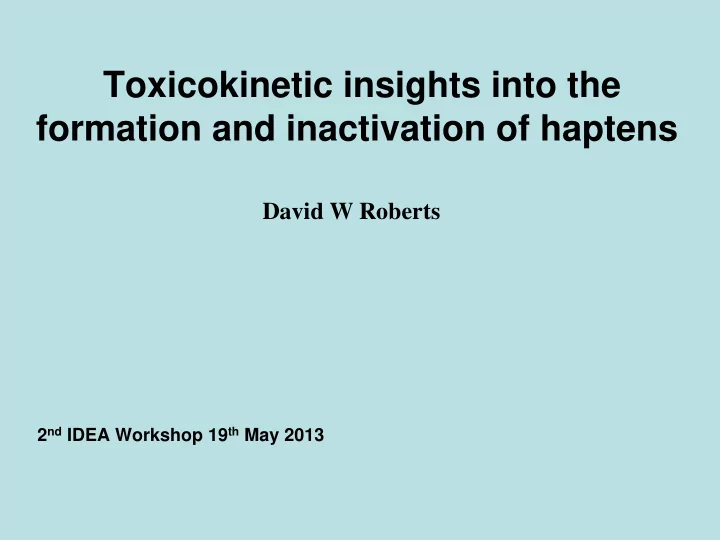

Toxicokinetic insights into the formation and inactivation of haptens David W Roberts 2 nd IDEA Workshop 19 th May 2013
What I do nowadays Consultant in Manufacturing and Toxicological Chemistry Honorary Researcher at Liverpool JM University Major activity in CD Quantitative Mechanistic Modelling (QMM), i.e. How can we use chemistry to decide if a chemical: - is a sensitizer or not - how potent it is, if at all
The difference between pro-haptens and pre-haptens Pro-haptens – metabolically activated to reactive haptens in cutaneo Pre-haptens – abiotically activated ex cutaneo Can we always/ever be sure?
A different difference Intrinsically allergenic - If not directly reactive, sensitizes via conversion to a reactive species under test or exposure conditions - Has a reproducible potency (eg EC3) Potential allergen precursor - Not significantly activated under test/exposure conditions, but has a tendency to form sensitizing impurities. - Does not have a reproducible potency (eg EC3 depends on storage/handling history)
Activation reactions Oxidation/autoxidation - C-H to Allylic/benzylic hydroperoxides - C=C to Reactive epoxides - CHOH to C=O - hydroquinones and catechols to quinones - etc Hydrolysis Cl C 9 H 19 C 9 H 19 Dehydrohalogenation O S O S O 2 O 2
Formation of allergens by autoxidation – how much and how fast? Several situations to consider: Reactivity-limited Mass-transfer-limited Oxygen availability limited Limited by stability of allergenic autoxidation products
Slow reaction, long time Lab model of a half-full storage tank, 25 ° C Air, ca 20% O 2 S(O 2 ) ca. 20mmol/L Pure limonene From original dissolved O 2 , with dissolved O 2 0.25% hydroperoxides From O 2 in original head-space + air intake, 0.14% Total maximum hydroperoxide level, 0.39%
Slow reaction, longer time Remove half the liquid in the tank The removed volume is replaced by air (20% O 2 ) Potential to form further 0.14% hydroperoxides Total maximum hydroperoxide level now 0.53%
Further removal of liquid Tank level Max. % oxidation products Half full 0.39 1/4 full 0.53 1/8 full 0.67 1/16 full 0.71 What does this mean for potency?
Limonene autoxidation OOH OOH O 2 + other + products EC3, 0.33% EC3, 0.83% pEC3, 2.6 pEC3, 2.2 Worst case assumptions: Only these hydroperoxides, no decomposition, fully cross-reactive, EC3 = 0.33%
Prolonged storage, occasional removal of liquid Tank level Max. % oxidation EC3 of air-exposed products limonene Half full 0.39 85% 1/4 full 0.53 62% 1/8 full 0.67 49% 1/16 full 0.71 46%
Fast reaction, O 2 mass-transfer limited, short-lived reactive allergen Example – poison ivy as a pre-hapten Oxidised to a short-lived ortho-quinone – protein reactive O OH O OH O 2 Degradation products R R o -quinone ? d [quinone]/ d t = k 1 [O 2 ] air [AESA/V] – k 2 [poison ivy][quinone] = 0 at steady state AESA = air exposed surface area; V = volume Steady state concentration of quinone = ( k 1 / k 2 ) [O 2 ] air [AESA/V]/[poison ivy]
Slow reaction, through current of air [O 2 ] remains steady at ca. 20 mmol/L d [ROOH]/ d t = k 1 [O 2 ][RH] – k 2 [ROOH] – k 3 [ROOH][RH] [Peroxide] vs Time 0,06 0,05 0,04 0,03 0,02 0,01 0 0 1 2 3 4 5
Mixture chemistry and kinetics In mixtures and formulations there is competition for O 2 , and some components will react more readily than others with hydroperoxides How competitive are aldehyde O=C-H against allylic C=C-C-H? How competitive are, e.g., limonene and linalool for O 2 ? Relative reactivities of limonene peroxides and linalool peroxides in epoxidation of linalool and limonene?
Mixture potency considerations If several allergens are present, to what extent is their potency: Additive or…independent By analogy with mixture toxicity in ecotox: If compounds A, B, C…are fully cross -reactive, potency is additive: (1/EC3)mix = f A /EC3 A + f B /EC3 B + f C /EC3 C … ( f A = fraction of A in mixture, etc) If they aren’t cross -reactive, EC3 mix = EC3 A /f A where A is the component closest to its EC3
Esters, R 1 -CO.O-R 2 Depending on R 1 and R 2 the - CO.O- group may: Be directly electrophilic – acyl transfer agent Activate reaction of a group in R 1 Be involved in reaction in R 2 (S N 2 leaving group) Get hydrolysed: Releasing an allergenic R 2 OH, or… Losing reactivity in R 1 , losing acyl transfer reactivity
Some esters Ester Mechanistic domain O OH Michael acceptor O O O Schiff base O OH Michael acceptor, acyl HO S O
Some esters Ester EC3 (%) Mechanistic domain O OH Michael acceptor 1.4 O O O Schiff base 2.4 O OH Michael acceptor, acyl NS HO S O
Some more esters Mechanistic domain EC3 (%) O CH 3 SN2 NS O O C 7 H 15 SN2 6.4 O O H SN2, pro-geraniol NS O
And two more Mechanistic domain EC3 (%) O H SN2, pro-geraniol NS O O CH 3 Acyl, pro-isoeugenol NS O OCH 3 O CH 3 Acyl, pro-eugenol NS O OCH 3
Key knowledge gaps – as I see it Extent of oxidation that is likely in common practice: storage/handling of “pure” materials Levels of potent sensitizers formed in model “typical” formulation mixtures in realistically simulated manufacturing, handling and storage conditions Mixture chemistry, relative rates, relative potencies. Mixture toxicity as applied to skin sensitization - Cross- reactive - Non-cross reactive Relative rates of oxidation of “classical” prehaptens vs other fragrance ingredients (eg aldehydes) Stability of key hydroperoxides etc.
Recommend
More recommend